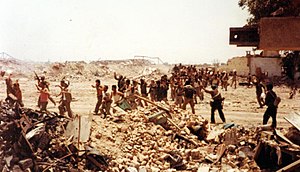Liberation of Khorramshahr
| Liberation of Khorramshahr | |||||||||
|---|---|---|---|---|---|---|---|---|---|
| Part of the Iran–Iraq War | |||||||||
 Iraqi prisoners of war |
|||||||||
|
|||||||||
| Belligerents | |||||||||
|
|
|
||||||||
| Commanders and leaders | |||||||||
|
|
|
||||||||
| Strength | |||||||||
| 70,000 | 70,000 | ||||||||
| Casualties and losses | |||||||||
| 15,000 killed and wounded 15,000-19,000 captured 550 tanks and armoured vehicles destroyed 105 tanks and armoured vehicles captured |
30,000 killed and wounded | ||||||||
The Liberation of Khorramshahr (Persian: آزادسازی خرمشهر Āzādsāzi-ye Khorramshahr) was the Iranian recapture of the port city of Khorramshahr from the Iraqis after 575 days on 24 May 1982 during the Iran–Iraq War. The Iraqis had captured the city early in the war on 26 October 1980 . The successful retaking of the city was part of Operation Beit ol-Moqaddas (Jerusalem). It is perceived as a turning point in the war and the liberation is celebrated in Iran on its anniversary, 24 May.
The city remained in Iraqi hands until April 1982, when the Iranians launched Operation Beit ol-Moqaddas to recapture the Khuzestan province. The first attack (from 24 April to 12 May 1982) utilized approximately 70,000 Iranian army troops and Revolutionary Guards that succeeded in pushing the Iraqi forces out of the Ahvaz-Susangerd area while sustaining heavy casualties. The Iraqis withdrew back to Khorramshahr and, on 20 May, launched a heavy but unsuccessful counterattack against the Iranians who stood their ground no matter the cost. An all-out assault on Khorramshahr was then launched by Iran, which captured two Iraqi defense lines in the Pol-e No and Shalamcheh region. The Iranians gathered around the Shatt al-Arab (known as Arvand Rud in Iran) waterway, surrounded the city and began a second siege. The Iranians finally recaptured the city on 24 May 1982 after two days of bitter fighting and heavy losses.
In re-taking the city, the Iranians captured approximately 19,000 soldiers from a demoralized Iraqi Army. On the other hand, Saddam Hussein was shocked and furious by the defeat in Khorramshahr and at the fact that the Iranians had pushed on despite sustaining heavy casualties. The Iranians had even been forced to commit their reserves in order to keep on driving back the Iraqis. Iranians had shown incredible determination and an iron will. Saddam ordered the execution of a number of top Iraqi officers responsible for the defense of the city. After the defeat at Khorramshahr, Saddam Hussein executed several of his top generals, such as the commander of the 9th Division.
...
Wikipedia
